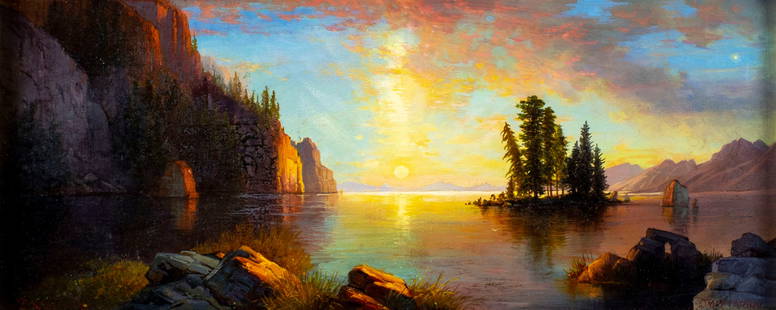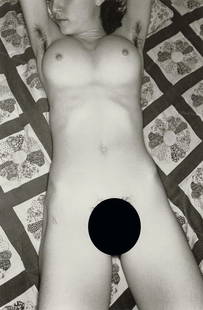
JOHN MCQUARRIE (American, 20th Century) Mural st
Similar Sale History
View More Items in PaintingsRelated Paintings
More Items in American Paintings
View More
Recommended Art
View More


Item Details
Description
Mural study of Sam Houston, circa 1934
Oil on canvas
31 x 30-1/2 inches (78.7 x 77.5 cm)
Public art in the United States enjoyed a renaissance of sorts in the 1890s and early 1900s, largely due to the murals painted for several world's fairs, especially the World's Columbian Exposition at Chicago in 1893 and the Panama-Pacific Exposition at San Diego in 1913. By the 1920s, mural painting began to wane, but Socialist muralists in Mexico, led by Diego Rivera, Jose Clemente Orozco, and David Siquieros, and the Great Depression caused another resurrection in the U.S. by the mid-1930s. President Franklin D. Roosevelt's New Deal included four major art programs which focused largely on mural painting: the Public Works of Art Project (PWAP); the Treasury Department's Section of Painting and Sculpture (The Section); the Treasury Relief Art Project (TRAP); and the Works Progress (later Projects) Administration's Federal Art Project (WPA/FAP). The general success of the "alphabet soup" art programs encouraged mural painting in the private section as well.
San Francisco sculptor and muralist John A. McQuarrie painted murals in Union Pacific, Central Pacific, and Southern Pacific railroad depots in California (Sacramento, Palo Alto, San Jose, and Salinas); Mesa, Arizona; and the Southwest. His most famous may be his Driving of the Golden Spike mural in Salt Lake City. In 1934, the Southern Pacific commissioned him to paint a 17 x 16 foot mural for Houston's now-demolished Grand Central Depot. The compositional sketch offered here is all that remains of McQuarrie's monumental tribute to the city of Houston and its namesake, Sam Houston.
When Sam Houston first came to Houston in January 1837, he saw only a log cabin and a dozen people. However, the founders of Houston, New York real estate promoters J. K. and A. C. Allen, hoped to make Houston the capital city of the Republic of Texas by promising government buildings and quarters for congressmen. McQuarrie's allegorical mural sketch depicts new construction in the fledgling city in the foreground, while the clouds in the background form the shapes of skyscrapers, railroads, and shipyards, showing Houston's ultimate promise. Enrico Cerrachio's bronze Sam Houston Monument, unveiled in Houston's Hermann Park in 1925, may have served as McQuarrie's inspiration for the mounted Sam Houston figure. Moreover, President Sam Houston rides a white horse in the mural, a clear reference to the myth of his having ridden a "white stallion"-actually a grey called Saracen - at the Battle of San Jacinto. The flag bearer waves a flag that may be an attempt by the artist to paint the first flag of the Republic of Texas.
Although McQuarrie had been painting murals since at least 1909, he clearly adapted his style to remain current. Although his Sam Houston mural was a private commission, it is consistent in style with those being painted under the fairly rigid dictates of the Federally-funded New Deal art programs. This is especially evident in the heavy outlines of the figures, so as to make them easier to "read" from distance, and the strong colors in the palette.
When Houston's Grand Central Station was demolished in the 1960s, an attempt to save the murals failed. Two different stories regarding the fate of the original mural survive today-one that the wall collapsed, and the mural was destroyed; and another that the mural was saved but, after being turned over to the National Guard for storage, was misplaced and lost. This study of Sam Houston was given by the artist to a Southern Pacific Baggage Master in the San Francisco depot, who became friends with McQuarrie while he was working for the railroad. Around 1955, it was given to the current owner's father after the Baggage Master learned that his neighbor had a family connection to Sam Houston's wife.
John McQuarrie's 1934 Grand Central Station mural of Sam Houston entering the city of Houston no longer exists. This sketch is all that survives of the original, which can now only be seen in photographs. Although McQuarrie may not be well known by some Texas art and Texana collectors, there is no denying that this piece is a unique opportunity to own an important piece of Texas art and history, as well as a great symbol of the growth and dynamism, which has characterized the city of Houston from its founding to the present day.
Buyer's Premium
- 25% up to $50,000.00
- 20% up to $1,000,000.00
- 12% above $1,000,000.00
JOHN MCQUARRIE (American, 20th Century) Mural st
Shipping & Pickup Options
Item located in Dallas, TX, usPayment































![McCoy, John [American, 1910-1989] watercolor painting: McCoy, John [American, 1910-1989] watercolor painting of a schooner and a beach with gulls, signed "John McCoy". Unframed. 22.5"h.x30"w.](https://p1.liveauctioneers.com/463/81908/42471492_1_x.jpg?height=310&quality=70&version=1447185717)















































